| written 7.1 years ago by | modified 3.1 years ago by |
Explain different handoff strategies in Details including hard, soft, delayed forced handoff
| written 7.1 years ago by | modified 3.1 years ago by |
Explain different handoff strategies in Details including hard, soft, delayed forced handoff
| written 3.1 years ago by |
There are two basic types of Handoffs.
1) Hard Handoff
2) Soft Handoff
1) Hard Handoff:
It is also known as “Break before make” connection.
In this type of handoff the link to the old base station is terminated before the mobile station establishes a link with the new base station.
It is used in FDMA and TDMA based mobile system.
Figure shows the mechanism of hard handoff.

Hard handoff is classified as
a) Intra cell handoff:
In Intra cell Handoff, the handover occurs within the same cell.
Intra cell handover switches a cell in progress from one physical channel of a cell to another physical channel of the same cell.
b) Inter cell handoff:
In Inter cell Handoff, the handover occurs between two cells.
The inter cell handover switches a cell in progress from one cell to another cell.
It can be of two types
1. Inter BSC: Here the MS moves from one cell to another cell controlled by the different BSCs.
2. Inter MSC: Here the MS moves from one cell to another cell controlled by the different MSCs.
c) Inter System Handoff:
In inter system handoff; the handover occurs between two systems.
This type of handoff occurs when the mobile unit moves from one cellular system to a different cellular system.
Example from GSM to UMTS.
2) Soft Handoff:
It is also called as Mobile Directed handoff or make before Break Connection.
In these types of handoff the link to the old base station is not terminated before the mobile station established a link with the new base station.
Once the link is established the connection to old BS is terminated.
It is used in UMTS to improve the signal quality
It is more seamless handover.
Figure shows the mechanisms of soft handoff.
